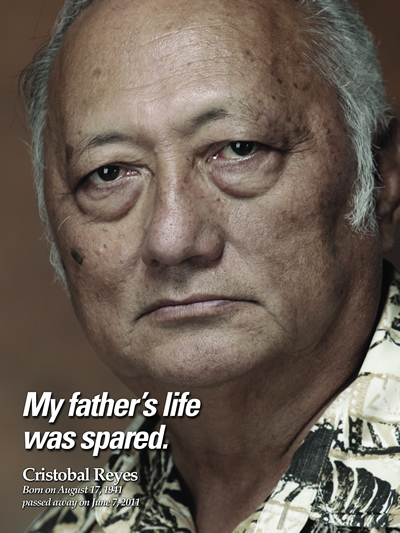 My name is Chris Reyes, and I’m here this afternoon to share the story of my father, Enrique Chaco Reyes. I am the oldest son of Enrique, and I was an infant during the occupation of Guam. But my father shared these atrocities with me, and today I’m here to share this story with you.
My name is Chris Reyes, and I’m here this afternoon to share the story of my father, Enrique Chaco Reyes. I am the oldest son of Enrique, and I was an infant during the occupation of Guam. But my father shared these atrocities with me, and today I’m here to share this story with you.
Prior to the Japanese invasion, my father worked as a farmer at the Fenna Valley. He was 27 years old when the Japanese invaded Guam. He was fair complexioned and was muscular, which lead to the Japanese belief that my father was part American. This notion lead to a series of beating and torture at the hand of the Japanese because -- he became a prisoner of war until a friend, who happened to be a Japanese himself, Mr. Francisco Okiyama, managed to convince the Japanese that my father was not an American, but of Chinese ancestry. This stopped the physical brutality and the imprisonment.
My father's life was spared, but did not relieve him from further hardship caused by forced labor he had to endure and having to be taken away from his wife and children, never to see them throughout the ordeal of the Japanese. Because of his physical build, he was made to carry military hardwares, Japanese hardwares, such as oxygen tanks, acetylene bottles, and ammunition from the ship docked a mile away from shore. He had to carry these supplies to shore to their destination. He eventually found himself back at Fenna when all the workers were relocated there.
While at Fenna, he worked for the Japanese in the field crops. It was shortly after my father had to move to Fenna when he was made aware that the Americans were on their way to Guam. This alerted the Japanese and started ridding the islands of as much Chamorros as they can, so that it will help weaken the attack against them whenever it was to take place. This is what led to the massacre of Fenna.
On one particular morning, all the people were gathered to go into several of the caves that were existed there. My father was in one of them. He was later called out by the Japanese to collect firewood and barks of trees to place in front of the cave. Up to this time, there was no mention or notice of machinegun position to fire directly in front of the cave. He witnessed the first cave was being set on fire at the entrance, and then was followed by shootings.
This scared my father so much that he run away and sought refuge in the jungle. He went in the direction towards Manenggon to seek for his wife and children. He made it back to his family and there he remained after three years of not seeing them, knowing if they were even alive.
Yes, it was a happy ending for our family, but my father died only three years ago and yet he never got over the experience he encountered in the Japanese occupation of Guam. No matter how he shared this story with the children, grandchildren and great grandchildren, he would always tear and show emotion as to what happened to him, like it happen yesterday and not 60 years ago.
Real People. Real Stories. A weekly testimonial series provided by the Office of Senator Frank F. Blas, Jr. The testimony of Cristobal Reyes is recorded in the Guam War Claims Review Commission public hearings held in Hagåtña, Guam on December 8, 2003. This story sponsored by the community involvement of Younex Enterprises Corporation. Photo courtesy of Expressions Studio.
 |
 |
